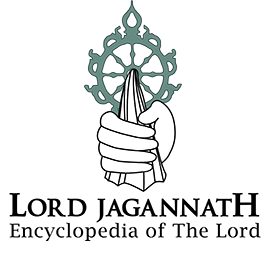King Indradyumna’s arrival at Purusottama Kshetra
King Indradyumna of the prosperous city-state Avanti had been in quest of a most appropriate way to worship Lord Sri Hari whose providence includes both Bhoga and Mokshya [worldly pleasure as well as liberation]. Initially, he considered the ways mentioned in Tantra, Agama, Vedanga, Purana [myths], Itihasa [history] and the ones shown by sages. Accordingly, he spent time serving Brahmins proficient in The Vedas and wise old people. He was also strict about gaining control over his senses. To find a way to Mokshya was his primary concern.
One day, with a team of large number of people consisting soldiers, priests, women from the royal palace, servants and numerous other people from different occupations, he set out from the city of Avanti. Armed soldiers on chariots followed the king. Behind them marched soldiers on foot skilled in using all kinds of weapons. Close to the king were all the women from the ladies section of the palace wearing elegant clothes and jewelry. Along with the Brahmins and the Kshatriyas, there were also the Vaishyas; there were businessmen with their families and precious possessions who had joined the team. Thus, the king with the large groups of people travelled south and reached the sea-shore on the south.
The king beheld the sea and the high waves and found in amazement the evidences of the various aquatic life and precious stones the sea was teeming with. Since several rivers fell into this sea of saline water, it was metaphorically a swami to all those rivers. It was considered extremely sacred and was also capable of removing all kinds of sins and fulfilling all wishes. Therefore, the king considered himself fortunate enough to find such a holy place and decided to reside near it with his people.
He began to explore the new place. At first, he saw beautiful natural spots and rivers. There flowed a big river called Svitrotpala, which rose from the Vindhya Mountain. It was also known as The Mahanadi. Several villages and towns stretched along its sides and the people living there were healthy. The Brahmins, the Kshatriyas, the Vaishyas and the Shudras were living together in peace and sincerely busy in their respective occupations. The Brahmins were proficient in the vedas and recited the slokas [hymns] with perfect enunciation, rhythm and order. There were palaces, temples, assembly platforms, daises, roads, forests and parks. Lots of people gathered in those places to listen to purana, veda, itihasa, vedanga and poetry. The women were proud of their beauty and long youth. These women had all those physical and behavioral attributes that were befitting to a highly cultured woman. The king saw in the place many celibate monks, penitents and people who had achieved perfection in Mantras and Yajnas. The king also found the legendary Vata Vriksha [the perennial pipal tree] in that place. The story of the disappearance of the blue-sapphire statue of Lord Shri Hari (Vishnu) from Purusottama Kshetra also came to his mind. All these evidences made him feel sure that he had finally arrived at Purusottama Kshetra and resolved to live there permanently worshipping Lord Sri Hari.
“I want to do here something worthy” said the king to himself, “which will please Lord Vishnu and qualify me to have a darshan of Him [to literally see Him with his mortal eyes]. I will keep my mind focused always on God and perform Yajna, give daana, do meditation, conduct worship, keep fast according to the rules mentioned in scriptures and start the construction-work of a temple for the Lord.”
Thereafter, King Indradyumna prepared himself to have the temple built at Purusottama Kshetra and took the help of other kings to successfully complete the construction of the temple.
Reference
Brahma Purana
